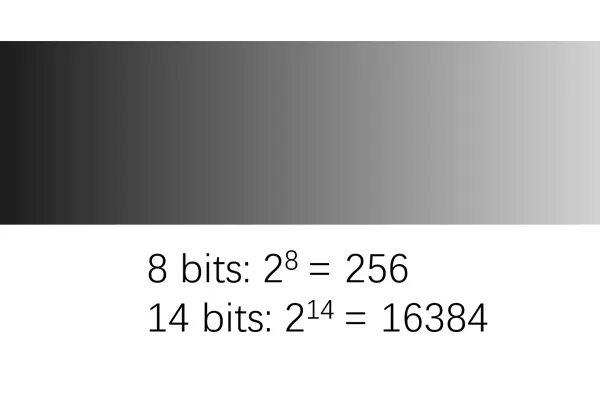Are you planning to get an LED display? Well, there are many things that you should do before buying. First, most of us are pretty familiar with the types of display screens. We know how they work.
But still, there are many phenomena most people don’t understand. And I think they sometimes don’t get the LED video wall they need due to this lack of knowledge. Likewise, the term grayscale might strike some confusion in your mind.
Grayscale is the range of shades that starts from black and ends in white. It is essential for the quality of display content. The higher the grayscale is, the better you will experience the visual effects on the LED screen.

In this post, I will discuss the Grayscale of LED displays in detail.
What does it mean by grayscale?
First, I will explain grayscale in terms of color science. It is a range of grey shades from black to white, as used in displays or printouts. It doesn’t have any observable color in it.
In these grey shades, black is the darkest color. And black does not reflect light. Thus, it does not have any reflected light in color. But, at the same time, white is the lightest color. Therefore, it allows the complete transmission of light.
As I have mentioned above, grayscale is the range of shades. There are 256 shades in it. This range starts in black and ends in white. And all these shades or colors originate from the primary colors of RGB, i.e., Red, Green, and Blue. Isn’t it amazing?
Grayscale range means how many shades a color can have, from dark to light. Now, let us see this in terms of display technology. Here, it is the factor that determines the number of colors displayed. For example, we use grayscale in the graphical display of LED screens. If the gray level is high, then:
- The colors will be rich.
- The pictures will be more pleasing.
- High quality of the image.
- The details will be of prime quality.

How does the Grayscale work in the LED display?
As mentioned above, the higher the grayscale, the better the image quality. But grayscale alone cannot increase the quality of the display. It depends on four main things:
- The digital to analog conversion of the system
- Video processing chip of the system
- Transmission system
- The memory of the system
These parts of the system must support the corresponding bits. If they do, then the grayscale can enhance the display of content. So all these components go all in hand in working.
Now let’s talk about the bits of grayscale. We have the following bits processing systems:
1) 1-bit processing system (2 1 power). It is 2 gray levels which means that it has two shades. And there are two changes in brightness from black to white. So we can set up two kinds of luminance.
2) 2-bit processing system (2 2 power). It is 4 gray levels which means that it has four shades. And there are four changes in brightness from black to white. So we can set up four kinds of luminance.
3) 3-bit processing system (3 2 power). It is 8 gray level which means that it has eight shades. And there are eight changes in brightness from black to white. So we can set up eight kinds of luminance.
4) 4-bit processing system (4 2 power). It is 16 gray level which means that it has 16 shades. And there are 16 changes in brightness from black to white. So we can set up 16 kinds of luminance.
5) 5-bit processing system (2 5th power). It is 32 gray level which means that it has 32 shades. And there are 32 changes in brightness from black to white. So we can set up 32 kinds of luminance.
6) 6-bit processing system (2 6th power). It is 64 gray level which means that it has 64 shades. And there are 64 changes in brightness from black to white. So we can set up 64 kinds of luminance.
7) 8-bit processing system (2 8th power). It is 256 gray levels which means that it has 256 shades. And there are 256 changes in brightness from black to white. So we can set up 256 kinds of luminance.
8) 10-bit processing system (2 10th power). It is 1024 gray level which means that it has 1024 shades. And there are 1024 changes in brightness from black to white. So we can set up 1024 kinds of luminance.
9) 12-bit processing system (2 12th power). It is 4096 gray level which means that it has 4096 shades. And there are 4096 changes in brightness from black to white. So we can set up 4096 kinds of luminance.
10) The 14-bit processing system (2 14th power). It is 16384 gray level which means that it has 16384 shades. And there are 16384 changes in brightness from black to white. So we can set up 16384 kinds of luminance.

Nowadays, most LED displays mainly adopt the following bit processing systems:
- 8-bit processing system
- 10-bit processing system
- 12-bit processing system
- 14-bit processing system
- 16-bit processing system
It is a fact that the higher the grayscale, the higher the quality of content. It is because the quality of the content will be more prosperous and vivid. For instance, when we compare 8-bit and 10-bit, 10-bit gives a better quality display. Similarly, if we consider 10 bit and 12 bit, 12 bit is far better than 10 bit.

How can we control the grayscale of the LED display?
There are two methods to control the grayscale. I will explain them both.
- First, we can control the grayscale by changing the current. Generally, the continuous current flowing through the display is around 20 mA. The grayscale is proportional to the current flowing through the screen. We can change the current to control the grayscale.
- Second, we can control the grayscale by modulating the pulse width. By regulating the pulse width, we can change the optical pulse width.
But which method is more suitable? Changing the pulse width is preferable as it is ideal with pulse width regulation. Almost all display screens use this to control the grayscale.
Levels of Grayscale:
I have discussed above that all display components go hand in hand in working. Thus, all these must be compatible with the higher bits to function correctly. Now we will discuss the two types of LED display grayscales. What levels of grayscale or bits support which kind of display screen?
13-bit grayscale works fine with most indoor and outdoor LED displays we use nowadays. But, these display screens do not show much of gradient pictures. Thus, these display screens are suitable with a 13-bit grayscale system. Moreover, it effectively shows the image and content of these display screens.
If we talk about other screen types that show gradient images, 13-bit grayscale is not a perfect idea. They must have a higher-bit grayscale system. They need a 14-bit or 16-bit grayscale at least or even higher. Then, they can display lyrical and rich content on screen.

Conclusion:
Above, I have tried to explain what grayscale means in display technology. How grayscale affects the quality of the display? And how Grayscale works with other components of the screen. I hope so; you have a better understanding now. With this knowledge, you will get the best-LED display that best suits you.


